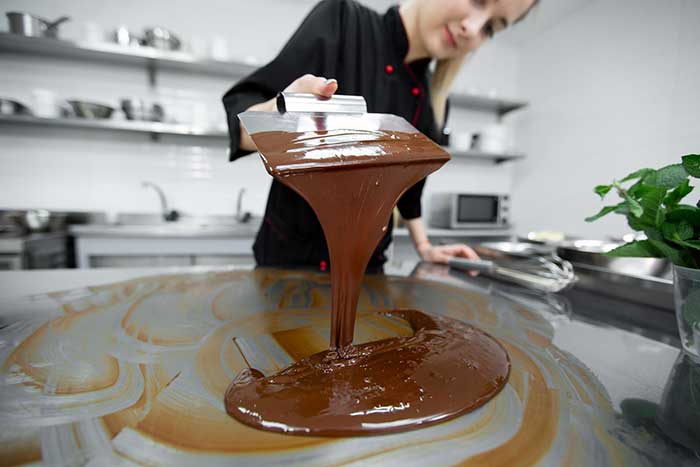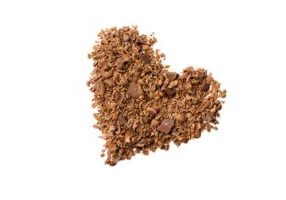BLOG
Snap, Crackle, and Shine: The Science of Perfecting Chocolate Tempering

Tempering is a crucial step in the bean-to-bar chocolate making process that transforms cacao beans into smooth, glossy chocolate bars with the perfect snap. This delicate dance of heating and cooling the chocolate is essential for achieving the desired texture, appearance, and stability of the final product.
The tempering process occurs after the cacao beans are harvested, fermented, dried, winnowed, ground and conched (….phew…), after which the mixture is transformed into the smooth, glossy chocolate we know and love via the magic of chocolate tempering.
Understanding the Science Behind Chocolate Tempering
To master the art of chocolate tempering, it’s important to understand the science behind it. At the heart of this process are cocoa butter crystals, which play a vital role in determining the chocolate’s texture, shine, and melting behavior.
Cocoa butter, the main fat in chocolate, can crystallize into six different forms (I to VI), each with unique properties that affect the final chocolate’s quality. The tempering process aims to manipulate these crystals to achieve the desired form V, which gives properly tempered chocolate its signature qualities.
The Six Types of Cocoa Butter Crystals and Their Properties
The six cocoa butter crystal forms and their properties are:
- Form I: Melts at 17°C (63°F), soft, crumbly, and prone to blooming
- Form II: Melts at 21°C (70°F), soft, crumbly, and prone to blooming
- Form III: Melts at 26°C (78°F), firm but with a poor snap and melts easily
- Form IV: Melts at 28°C (82°F), firm with a good snap but melts easily
- Form V: Melts at 34°C (94°F), glossy, firm, snaps well, and melts near body temperature
- Form VI: Melts at 36°C (97°F), hard and slow to melt in the mouth, with visible blooming
Form V Crystals: The Desired Result of Tempering
Form V crystals are the ultimate goal of tempering, as they provide the perfect balance of texture, appearance, and stability. Chocolate with a high proportion of form V crystals will have a glossy sheen, a satisfying snap when broken, and a smooth, creamy mouthfeel that melts near body temperature.
Crystal Clear: The Temper-mental Nature of Chocolate
Achieving the perfect temper requires precise control over temperature, time, and agitation. The process involves melting the chocolate to eliminate any existing crystals, cooling it to encourage the formation of form V crystals, and then gently reheating it to maintain the desired crystal structure.
Melting, Cooling, and Reheating Stages
During tempering, the chocolate is first heated to above 45°C (113°F) to melt all existing crystals. It is then cooled to allow form V crystals to develop and serve as “seeds” for the remaining cocoa butter to crystallize around. Finally, the chocolate is reheated to just below the melting point of form V to eliminate any lower-form crystals that may have formed.
Precise temperature control is essential for successful tempering. Even slight deviations can lead to the formation of undesired crystal forms, resulting in chocolate with a dull appearance, soft texture, and a tendency to melt easily or develop unsightly fat bloom.
Achieving the Perfect Snap, Shine, and Mouthfeel
A well-tempered chocolate bar will have a glossy sheen, a crisp snap when broken, and a smooth, creamy mouthfeel that melts near body temperature. These qualities are the hallmarks of a properly tempered chocolate and are essential for creating a satisfying sensory experience.
Temper, Temper: Perfecting the Art of Chocolate Alchemy
Mastering the art of chocolate tempering requires a combination of skill, patience, and practice. Whether you’re a professional chocolatier or a home enthusiast, understanding the techniques and equipment used in tempering can help you create chocolate bars that are both visually appealing and delightfully delicious.
Below is a brief overview of some of the possible tempering techniques. For more info, see our article on comparing different chocolate tempering techniques
Traditional Hand-Tempering Techniques
Traditional hand-tempering techniques, such as seeding and tabling, involve manipulating the chocolate’s temperature and crystal structure through manual methods. These techniques require a keen eye, a steady hand, and a deep understanding of the tempering process.
Seeding and Tabling Methods
Seeding involves adding a small amount of tempered chocolate to the melted chocolate to introduce form V crystals and encourage their growth. Tabling, on the other hand, involves spreading the chocolate on a marble slab and working it with a spatula to cool it and promote crystal formation.
The Importance of Patience and Practice
Mastering hand-tempering techniques takes time and practice. It’s important to be patient and persistent, as even experienced chocolatiers may need to rework a batch of chocolate if the temper isn’t quite right.
Modern Tempering Equipment
In addition to traditional hand-tempering methods, many chocolatiers and chocolate makers now use modern tempering equipment to streamline the process and ensure consistent results.
Tempering machines are designed to precisely control the chocolate’s temperature and agitation, making it easier to achieve a perfect temper every time. These machines can be a valuable investment for chocolate makers who want to produce large quantities of consistently tempered chocolate.
Advantages and Disadvantages of Automated Tempering
While tempering machines offer convenience and consistency, they can also be expensive and may not provide the same level of control and flexibility as hand-tempering methods. Some chocolatiers prefer the traditional approach, as it allows them to fine-tune the tempering process to their specific needs and preferences.
Temper Traps: Troubleshooting Common Tempering Issues
Even with the best techniques and equipment, tempering can sometimes go awry. Knowing how to recognize and troubleshoot common tempering issues is essential for any chocolate maker.
Recognizing Improperly Tempered Chocolate
Improperly tempered chocolate can be identified by its dull appearance, soft texture, and tendency to melt easily or develop fat bloom. These issues arise when the cocoa butter crystals are not in the desired form V state.
Dull Appearance, Soft Texture, and Melting Easily
Chocolate that lacks the glossy sheen and crisp snap of properly tempered chocolate may have a higher proportion of lower-form crystals (I to IV). These crystals melt at lower temperatures, resulting in a soft texture and a tendency to melt easily.
Fat Bloom and Its Causes
Fat bloom, characterized by a whitish, dusty appearance on the chocolate’s surface, occurs when cocoa butter separates from the chocolate and recrystallizes on the surface. This can be caused by improper tempering, exposure to heat or humidity, or storage at fluctuating temperatures.
Correcting and Preventing Tempering Mistakes
When tempering issues arise, it’s important to know how to correct and prevent them to ensure the quality and consistency of your chocolate.
Improperly tempered chocolate can often be reworked by remelting it and starting the tempering process anew. This allows you to break down the undesired crystal forms and re-establish the proper crystal structure.
To prevent issues like fat bloom and maintain the quality of your tempered chocolate, it’s crucial to store it in a cool, dry place with stable temperatures. Avoid exposing the chocolate to heat, humidity, or strong odors, which can affect its texture and flavour.
Temper Tantrum-Free: The Joys of Well-Behaved Chocolate
When chocolate is properly tempered, it not only looks and tastes better but also behaves better. Well-tempered chocolate offers a range of benefits that make it a joy to work with and consume.
A well-tempered chocolate bar is a feast for the senses, with its glossy sheen, satisfying snap, and smooth, creamy texture.
The glossy surface and crisp snap of properly tempered chocolate are the result of a high proportion of form V crystals, which create a stable and uniform crystal structure.
As tempered chocolate melts in the mouth, it releases its flavours and aromas, providing a luxurious and indulgent sensory experience. The smooth, creamy texture is a hallmark of well-tempered chocolate and is highly prized by chocolate lovers.
Shelf Stability and Resistance to Bloom
In addition to its sensory appeal, properly tempered chocolate also offers practical benefits, such as increased shelf stability and resistance to fat bloom.
The stable crystal structure of tempered chocolate helps to prevent the separation of cocoa butter and other ingredients, which can lead to texture and flavour deterioration over time. This increased stability allows chocolate to maintain its quality and freshness for longer periods.
For artisan chocolate makers, proper tempering is essential for creating confections that not only taste great but also maintain their appearance and texture. Well-tempered chocolate is less likely to develop fat bloom or other visual imperfections, ensuring that your creations look as good as they taste.
Conclusion
Chocolate tempering is a fascinating blend of art and science, requiring a deep understanding of the complex nature of cocoa butter crystals and the skill to manipulate them into the desired form. By mastering the techniques and principles of tempering, chocolate makers can elevate their craft and create truly exceptional bean-to-bar chocolate.










